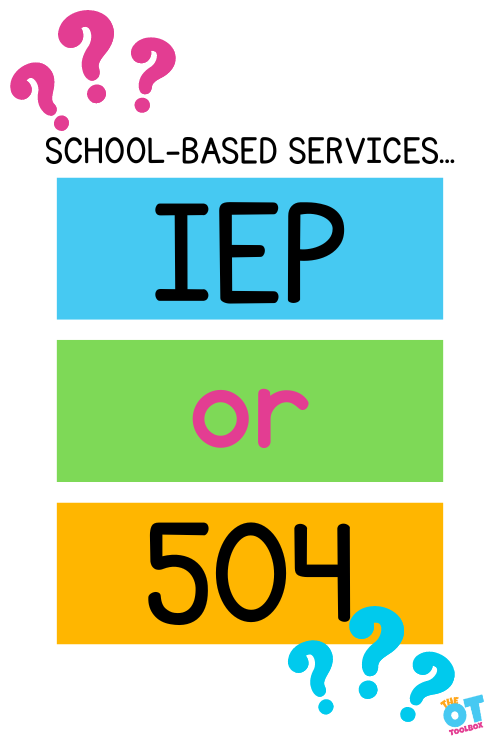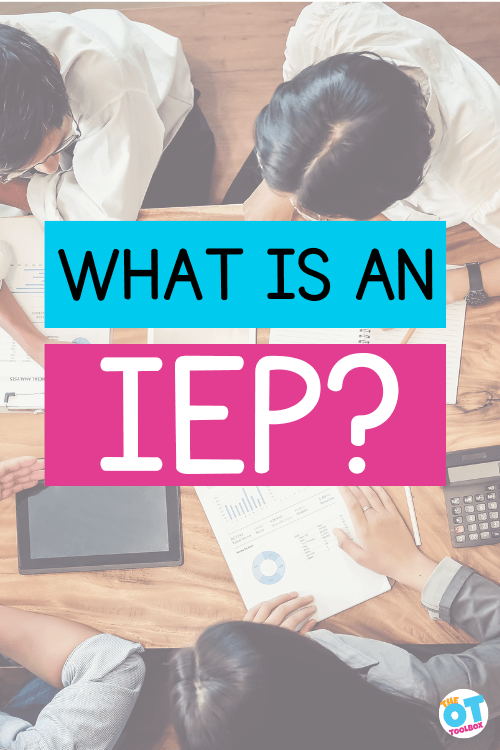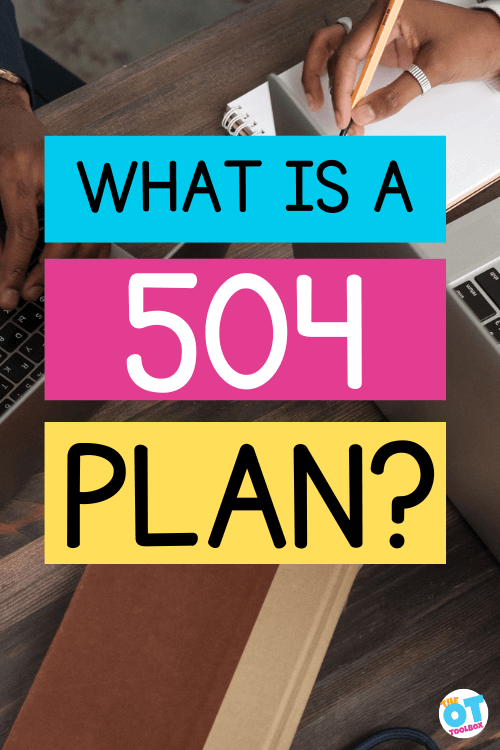If you have a child who has specific needs and are new to the school supports or are a new school-based OT, knowing the differences between IEP and 504 is a pivotal piece of getting started with a team approach to support in the school system. This post aims to unravel what is a 504, an IEP, and what is the difference between them.

Differences between IEP and 504
School services are full of confusing terms and acronyms. IEP and 504 are two of those support services terms. So, which is it that a particular student needs…an IEP or 504? What are these, who qualifies for them, and what assistance do they provide students?
It’s important for the school based occupational therapy professional, parents, and the whole intervention team to understand differences between the IEP and a 504 plan.
It is difficult enough to be faced with enrolling your child into school. Now imagine knowing, or finding out they have a disability. This adds to the confusion and angst, especially when trying to make sure they have all of the help they need for success. There are many options for learners with disabilities including an IEP or 504 plan.
Similarities between an IEP and a 504
Both an IEP and a 504 are plans that must be upheld. They are documents that are created for specific reasons. Both documents are created by a team who meet the individualized needs of the student.
For example, a student might need to use the school sensory room and this can be included in the IEP or 504 plan.

What is an IEP?
According to the DO-IT program (Disabilities, Opportunities, Internetworking, and Technology) “The Individualized Educational Plan (IEP) is a plan or program developed to ensure that a child who has a disability identified under the law and is attending an elementary or secondary educational institution receives specialized instruction and related services”.
The IEP provides special education and services to a student whose disability is negatively impacting their ability to receive academic instruction.
Students on an Individualized Education Program (IEP) are entitled to a range of supports and services to ensure they receive an appropriate education that meets their specific needs. The entitlements of students on an IEP can vary depending on the laws and regulations of the specific country or educational system.
Here are some common entitlements often provided to students on an IEP:
- IEP development by a team of professionals, including parents, teachers, and special education staff
- Modification of curriculum
- Classroom accommodations to support their access to the general education curriculum
- Specialized instruction in small groups, one-on-one, repeated instruction, or other instruction methods
- Related services such as occupational, physical, and speech therapy that support the student’s education
- Transition Planning: Students with an IEP who are approaching the transition to adulthood are entitled to receive transition planning services. This includes assistance in developing goals and plans for post-secondary education, vocational training, employment, independent living, and community participation.
- Regular Progress Monitoring: Students on an IEP have the right to have their progress regularly monitored to ensure they are making appropriate academic and developmental gains. Progress may be measured through assessments, observations, and data collection to inform instructional decisions and make adjustments to the student’s program as needed.
It’s also important to note that the specific entitlements and rights of students on an IEP can vary by state so be sure to refer to the laws and regulations in your specific area for a comprehensive understanding of student IEP entitlements.
The written IEP “plan” includes sections such as:
- Present levels of performance – This article on the OT Toolbox provides great information about highlighting student strengths on an IEP
- Goals – here is a great post about setting goals
- Services offered – therapy, frequency, duration, service model
- Benchmark performance (standardized testing or data gathered)
- Least restrictive environment – students should be provided services in the least restrictive environment, providing inclusion into mainstream education as tolerated
- Assistive technology – description of any technology a student needs in order to participate in school work
- Accommodations and modifications to the environment or curriculum to promote success
- Discussion of options for extended school year if appropriate

What is a 504?
The 504 Plan is a plan developed to ensure that a child who has a disability identified under the law and is attending an elementary or secondary educational institution receives accommodations that will ensure their academic success and access to the learning environment.
In order to qualify for a 504 plan, a student’s diagnosis must restrict one or more major life activities (attention, class participation, test taking). Simply having a diagnosis does not mean a student needs a 504 plan.
The 504 plan can provide extended time or small group administration for testing. It allows for accommodations like frequent breaks, fidgets, sensory accommodations, preferential seating, or modified homework assignments.
NOTE: the student is not eligible for direct related services such as physical, occupational, or speech therapy services through a 504 plan.
The IEP and 504 are similar in that they both:
- Provide accommodations at no cost. Types of accommodations might include visual accommodations, handwriting accommodations, or other areas that impact the student’s ability to participate in their education.
- Are reviewed yearly
- Require student reassessment every three years
- Have parent engagement throughout the process
- Involve student strengths in the classroom
There are several main differences when deciding between an IEP or 504 plan:
- Parents have fewer rights, and schools have less legal obligations under a 504 plan
- Mandated by law – an IEP is required under the Individuals with Disabilities act, whereas the 504 is part of the rehabilitation act that guarantees certain rights to people with disabilities
- IEP Qualification – based on 13 disability categories versus a 504 which is based on a record of impairment. More than 13 disabilities qualify for 504 plans, often including students who do not qualify for assistance under an IEP but still require accommodations
- Contents – IEP plans have to be in writing, 504 plans do not. IEPs require formal written goals and objectives, and evidence of growth
- Parental involvement – IEP requires that schools make efforts to insure parent participation including notice of meetings. 504 plans do not require notice of meetings
- Placement – IEP requires parental involvement before a change in placement, 504 does not
- Expulsion – students with a 504 can be expelled for behavior that is not related to their disability, where those with an IEP are still entitled to a free and public education
- Funding – states receive funding for students with an IEP, but do not receive additional funding for those on a 504 plan
There are also Subtle Differences when deciding between an IEP or 504 plan:
- Not all students who have a disability require an Individualized Education Plan or 504. Their disability must be impacting their education in some way for them to qualify.
- An IEP requires evidence and documentation of growth, where a 504 is more of a loosely formulated plan
- Students with a 504 do not need specialized instruction, but accommodations to ensure they are able to access their environment and curriculum
- An IEP is more legally binding and specific than a 504 plan
IEP or 504 resources
Though the road can be long and tricky when navigating special education, there are resources available for parents and other caregivers:
- Connected Families – Parents Supporting Parents
- Study.com has put together a starter list of resources
- National PTA foundation – Special Education Resources
If you are wondering about how an IEP and/or 504 plan works because you think a child might need OT services, check out our resource on how to request an OT evaluation in schools. That blog post has a lot of information from the perspective of a school based OT who has seen how this process works!

Victoria Wood, OTR/L is a contributor to The OT Toolbox and has been providing Occupational Therapy treatment in pediatrics for more than 25 years. She has practiced in hospital settings (inpatient, outpatient, NICU, PICU), school systems, and outpatient clinics in several states. She has treated hundreds of children with various sensory processing dysfunction in the areas of behavior, gross/fine motor skills, social skills and self-care. Ms. Wood has also been a featured speaker at seminars, webinars, and school staff development training. She is the author of Seeing your Home and Community with Sensory Eyes.






